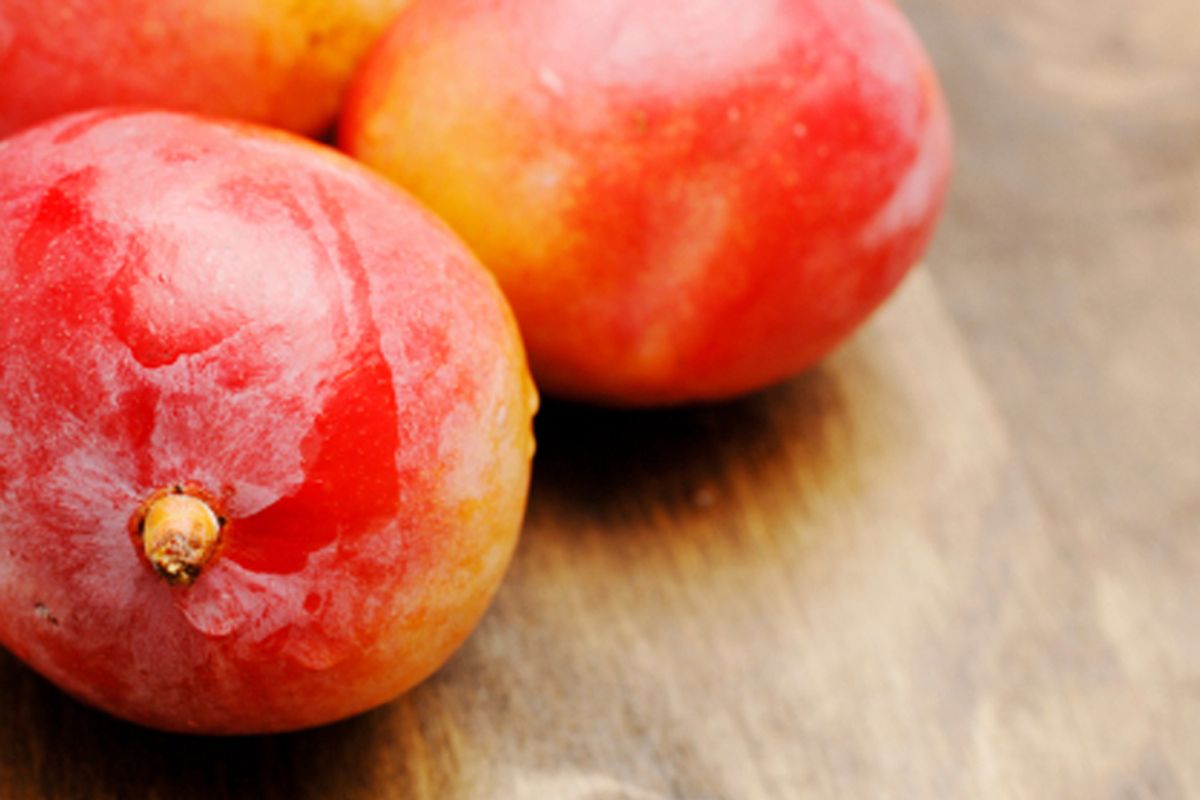In our rented jeep, we followed a slender Antiguan road through a small forest of mango trees, when my friend slammed on the breaks and began yelling. "Did you see that?" she asked, her heavy braids swinging as she swiveled her head. "Did you hear that?"
I didn't see or hear anything, but I was suddenly overwhelmed by the flowery honey scent of ripe mangoes and the harsher, alcoholic fumes from piles of fruit fermenting on the ground. And then I realized what she was so excited about. Mangoes were dropping from the trees in every direction. Some hit the ground with a dull thud, others fell silently and a few splatted spectacularly into puddles of fruity soup.
We gathered as many mangoes as we could carry and then some. They were mostly the common, slightly stringy variety we call Kidneys, but they were sweet and delicious. We bit into the skin and sucked the sun-warmed fruit through the jagged holes, tossing the shriveled remains out the window. It was like making out with a mango, and there is simply nothing else like its sugary, succulent kiss.
Arriving at an isolated white sand beach, we achieved the Gold Standard of mango eating: Biting into a ripe fruit while standing in the clear, warm Caribbean Sea and letting the golden juice run freely down our faces and arms. We rinsed clear of their stickiness and swam until sunset.
I have loved mangoes as long as I can remember, but following this extravaganza I had my first allergic reaction to the fruit. There are two kinds of mango allergies. One is a true allergy causing symptoms from watery eyes to anaphylactic shock in extreme cases. The other kind is much more common -- a contact dermatitis caused by a compound called urushiol found in the sap and the skin of the mango. Urushiol is the same toxin found in poison oak, which I am also highly sensitive to. (Family legend has it that a relative died from a severe case.)
The reaction doesn't happen right away, so it took me several years before I realized that my swollen, itchy mouth was the result of mango eating. The reaction is very uncomfortable and sometimes the invisible sandpapery blisters can expand into ugly, raw and painful spots on the lips.
So it was a little bittersweet last week when my loved one pushed his way through the tangle of brush and guinea grass to retrieve one perfect mango from the tree I had a planted a few years back. Deep purple and larger than my two hands, it was a magnificent specimen. I could not believe that I had produced a mango of this quality and size on my tiny plot of land. It was so beautiful I didn't want to eat it and I placed it on my kitchen table where it could finish ripening indoors without risk of being devoured by hungry birds or iguanas. It reddened and softened each day until a week later it smelled like warmth and sweetness itself, bursting sticky tears of mango sap at its base.
I learned that the fruit growing in my yard was most likely a large variety of Edward, known as one of the world's very best eating mangoes because of its sweetness and lack of the stringy fibers that can hamper enjoyment. Edward is one of the best mangoes around, but somewhat of a rarity because of its infamously low yield. My small tree had produced only one this year, but that Ed was sure a beauty.
Vanity, fear of those blisters, removes mangoes from their place at the very top of my fruit list, but I eventually learned that if I eat a large mango without touching the skin to my lips I can avoid a reaction. On further research, I realized that this is typical of most people sensitive to urushiol compounds. We can enjoy the fruit as long as we avoid the skin and the mango flesh in direct contact with the skin.
I have been seduced into sucking on a mango a few times since fully understanding the inevitable outcome. Last year, a friend gave me a bag of perfect deep yellow mangos that I simply could not resist. I had almost forgotten how different and downright sensuous it was to eat a mango this way. I did pay a price, but that time it was worth it.
While I will never make love to a warm mango again without consequence, I can enjoy them in other ways. My favorite is a large mango cooled in the fridge, the outermost flesh cut away, the rest cubed and eaten with a squeeze of fresh key lime juice. And now that I understand how to avoid an allergic reaction, I will never again turn my back on mango salsa -- delicious with chips or as an accompaniment to fish.
Mango Salsa
Ingredients
- 2 cups of cubed firm mango
- 1 small red onion chopped fine
- 1 jalapeno pepper chopped fine (leave the seeds in if you want a more fiery salsa)
- 1/3 cup chopped cilantro
- sea salt, to taste
- Juice of one large or two small limes (about three tablespoons)
Directions
- Mix all ingredients together and allow to sit for at least 10 minutes before serving. It's also delicious with a cubed avocado mixed in or some diced red pepper for extra color and crunch.



Shares